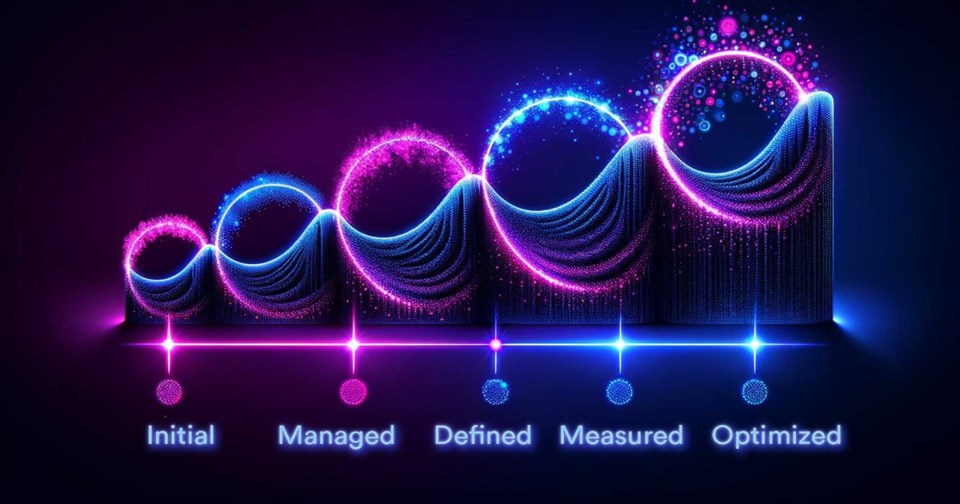Over the past 14 months, I’ve done dozens of focused on how to integrate and leverage AI across the enterprise. While generative AI is getting most of the attention, it is not an isolated technology. To get the most out of AI-enabled platforms, your business must be culturally and technologically ready to put it to work. One of the most common questions I hear from senior business leaders is, “How can we measure our AI readiness?” Which is quickly followed by, “Who’s doing it best in our category?”
It should not surprise you to learn that the quality of your proprietary (1st-party) data, access to relevant 2nd- and 3rd-party data, data governance and data hygiene are the fuel that powers any AI deployment. And, because AI is just another tool in your data tool belt, there is an extremely well-understood, practical way to assess if your business is ready for AI. Let’s review.
The AI Maturity Model
The Capability Maturity Model Integration (CMMI), a development model created in the early 1990s by the Software Engineering Institute (SEI) at Carnegie Mellon University is well-respected and widely used across various sectors to improve processes, especially in software development, engineering, and project management domains.
It is easily applied to single projects, divisions, or entire organizations and . Now, we have modified the CMMI to assist with assessing AI readiness.
Stages of AI Maturity
The CMMI assessment is a rigorous process improvement approach that has been refined over decades. Here are the five stages:
Initial (Level 1)
Processes are ad-hoc and chaotic. The organization may not have a stable environment necessary to produce quality products or services consistently.
Managed (Level 2)
Processes are planned, documented, performed, monitored, and controlled at the project level. It ensures projects are executed based on policy, employ skilled people who have adequate resources to produce controlled outputs, involve relevant stakeholders, are monitored, controlled, and reviewed, and are evaluated for adherence to their process descriptions.
Defined (Level 3)
Processes are well-characterized and understood, and are described in standards, procedures, tools, and methods. The organization’s set of standard processes, which is the basis for Level 3, is established and improved over time.
Managed (Level 4)
Processes are controlled using statistical and other quantitative techniques. At this level, organizations can measure the quality and efficiency of their processes and thus control them quantitatively.
Optimized (Level 5)
Processes are continuously improved based on a quantitative understanding of the common causes of variation inherent in processes. Level 5 focuses on continually improving process performance through both incremental and innovative technological changes/improvements.
Evaluation and Assessment
To help you understand where your project, team, or organization are on this scale, we conduct interviews and audits. These one-on-one sessions are used to determine what workflows and processes are currently in place, what data is available, and to identify gaps.
Aside from data management and governance, our AI readiness assessment models also focus on:
Technical Infrastructure: The readiness of the technical infrastructure to support AI initiatives, including computing resources, tools, and platforms.
Skills and Expertise: The availability of skilled personnel proficient in AI and machine learning technologies, and the organization’s capability in upskilling existing employees.
Use Case Identification and Implementation: The process for identifying, prioritizing, and implementing AI use cases, including the ability to pilot and scale AI solutions.
Monitoring and Maintenance: The mechanisms for monitoring AI systems’ performance, ensuring their reliability and trustworthiness, and updating them based on evolving data and requirements.
Ethics and Compliance: Ensuring AI systems adhere to ethical guidelines and regulatory requirements, including data protection and privacy concerns.
You Can Do This!
As AI capabilities continue to advance rapidly, assessing your organization’s readiness is crucial for successfully leveraging these technologies. By evaluating your current data infrastructure, skills, use cases, and governance through an AI maturity model, you can pinpoint areas for improvement. This will enable smart investments to elevate your AI competencies. Whether you are just beginning your AI journey or looking to optimize existing implementations, regularly checking your progress on the 5 levels of maturity will lead to impactful and ethical AI that drives transformative outcomes. With a fact-based understanding of strengths and gaps, you can build an AI-powered organization poised for long-term, sustainable competitive advantage.
Author’s note: This is not a sponsored post. I am the author of this article and it expresses my own opinions. I am not, nor is my company, receiving compensation for it. This work was created with the assistance of various generative AI models.
ABOUT SHELLY PALMER
Shelly Palmer is the Professor of Advanced Media in Residence at Syracuse University’s S.I. Newhouse School of Public Communications and CEO of The Palmer Group, a consulting practice that helps Fortune 500 companies with technology, media and marketing. Named he covers tech and business for , is a regular commentator on CNN and writes a popular . He's a , and the creator of the popular, free online course, . Follow or visit .




